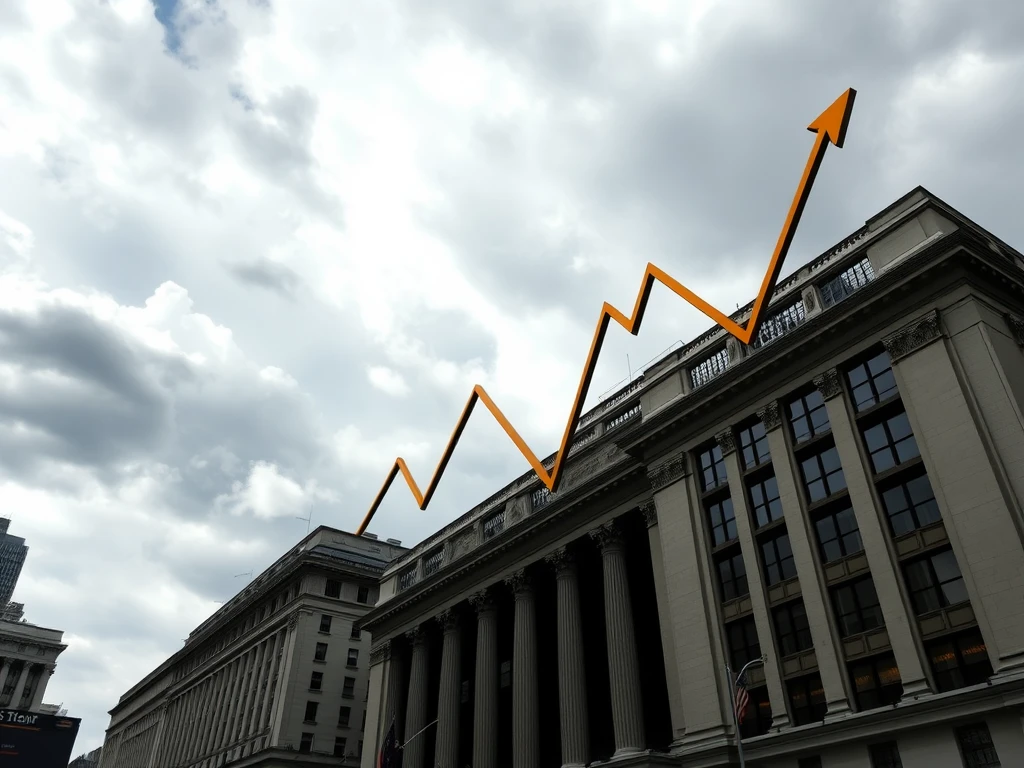Urgent Bitcoin Price Drop: Is the $80,000 Support Level About to Break?

Bitcoin’s rollercoaster ride continues! Crypto investors are waking up to a sea of red as the Bitcoin price has taken a tumble. But what’s behind this sudden downturn? Is it just another market correction, or are there deeper forces at play pushing Bitcoin lower? Let’s dive into the key factors causing today’s Bitcoin price drop and what it means for your crypto portfolio.
Why the Sudden Bitcoin Price Dip? Unpacking the Reasons
Several factors are converging to create this bearish pressure on Bitcoin. From macro-economic headwinds to shifts in investor behavior, let’s break down the main culprits:
- US Tariffs and Global Economic Uncertainty: Lingering concerns about the impact of US tariffs are casting a shadow over the market. These trade tensions fuel economic uncertainty, making investors risk-averse and less inclined towards volatile assets like Bitcoin.
- Sluggish Institutional Demand and Negative Bitcoin ETF Flows: The highly anticipated spot Bitcoin ETFs, once hailed as a game-changer for institutional adoption, are showing signs of cooling off. Recent data reveals net outflows from these ETFs, indicating a potential decrease in institutional demand.
- Fading Bullish Momentum: The market’s bullish fervor seems to have waned. The absence of strong buying pressure is making Bitcoin vulnerable to downward movements.
- Weak Whale Accumulation: Large investors, often referred to as ‘whales,’ are not accumulating Bitcoin at their previous rates. This reduced whale holdings activity suggests a lack of conviction among major players, further contributing to the price decline.
- Rejection at Key Trendlines: Bitcoin’s attempts to recover have been met with resistance at crucial trendlines, signaling persistent selling pressure.
Negative Bitcoin ETF Flows: Are Institutions Losing Interest?
Spot Bitcoin ETFs were expected to unleash a wave of institutional demand, and for a while, they did. However, recent data paints a different picture. Between March 28 and April 15, these ETFs experienced a significant $964 million in net outflows. This reversal suggests that institutional investors might be pulling back, at least temporarily.
Bitcoin ETF Outflows (March 28 – April 15)
Source: Farside Investors
CryptoQuant, a market intelligence firm, highlighted this trend, stating, “ETF demand is cooling.” Ki Young Ju, CEO of CryptoQuant, further emphasized the significance of this data, noting that a substantial decrease in ETF assets under management can indicate a “significant withdrawal of institutional investors.”
Bitcoin Bulls Missing in Action: Bearish Sentiment Grips the Market
Market sentiment has noticeably shifted towards bearish territory. CryptoQuant’s Bull Score Index, a key metric for gauging Bitcoin’s market health, has been below 50 for a prolonged period. This “Bull Off” signal, as CryptoQuant terms it, indicates a weakening or absence of bullish momentum. Historically, such prolonged periods of low Bull Score Index readings have coincided with market downturns.
Julio Moreno, Head of Research at CryptoQuant, pointed out the historical context, stating that similar patterns occurred during previous market declines in July 2021, January 2022, and June 2022.
Whale Holdings Decline: Is the Smart Money Selling Off?
Adding to the bearish signals, Bitcoin accumulation by whales appears to be slowing down significantly. Data reveals a decrease of approximately 30,000 BTC in whale holdings over the past week. Furthermore, their monthly accumulation rate has plummeted from 2.7% at the end of March to a mere 0.5%, the slowest pace since February. This slowdown in whale accumulation, particularly amidst concerns about US tariffs and trade tensions, raises questions about the conviction of large investors in the current market.
Key Price Levels to Watch: Will Bitcoin Hold Above $80,000?
Technically, Bitcoin’s current price drop is part of a broader downtrend that began after rejection from a major resistance zone. Bitcoin’s recent recovery attempt was capped by the 50-day and 200-day Simple Moving Averages (SMAs), acting as resistance levels.
The immediate support level to monitor is the psychological $80,000 mark. A break below this level could pave the way for further declines towards the $74,400 – $76,600 range, representing the lows from April 7 and March 11, respectively. According to Michael van de Poppe, founder of MN Capital, maintaining these levels is crucial for Bitcoin to sustain a bullish market structure.
#Bitcoin is still stuck in the range, and as long as it stays above $80K, I think we'll be fine with further upwards momentum on this one. pic.twitter.com/oIXG9FyqKS
— Michaël van de Poppe (@CryptoMichNL) April 16, 2025
Adding to the cautious outlook, the “death cross” pattern on Bitcoin’s daily chart remains in play, potentially dampening hopes for a quick recovery.
Navigating the Bitcoin Downturn: What Should Crypto Investors Do?
The current Bitcoin price correction serves as a reminder of the crypto market’s inherent volatility. While the reasons for the drop – US tariffs, cooling Bitcoin ETF demand, and weakened institutional demand – might seem concerning, it’s crucial to remember that market corrections are a normal part of the cycle.
Key Takeaways for Crypto Investors:
- Stay Informed: Keep a close eye on market indicators, ETF flows, and macroeconomic developments.
- Manage Risk: Ensure your portfolio allocation aligns with your risk tolerance.
- Zoom Out: Remember Bitcoin’s long-term potential and avoid panic selling during short-term dips.
- Do Your Own Research (DYOR): Before making any investment decisions, conduct thorough research and consider consulting with a financial advisor.
While the short-term outlook for Bitcoin price might appear uncertain, the crypto market is known for its resilience. Whether this dip is a temporary setback or a sign of a deeper correction remains to be seen. Keep a watchful eye on the key support levels and market indicators to navigate these potentially turbulent waters.
Disclaimer: This article is for informational purposes only and does not constitute financial advice. Crypto investments are inherently risky, and you could lose money. Always conduct your own research and seek professional advice before making any investment decisions.









